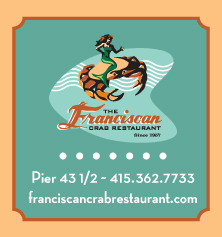Pet Pages
The leash is tightening on GGNRA dog policy comment period

eliminates over two-thirds of existing off-leash recreation area
The GGNRA is reported to be the largest urban national park unit in the world, stretching along more than 60 miles of Bay Area coastline. The key term here is park “unit” – this is a national recreation area, made up of approximately 76,500 acres of land spread over almost two dozen park territories.
The National Park Service describes the area this way: “For our neighbors who live and work in the Bay Area, we are their ‘backyard’ national park. The place where they windsurf, walk the dog, go for a run, or bring their kids to explore nature and get a taste of history.”
The GGNRA was established by Congress in 1972 under the criteria unique to national recreation areas: “Such areas should be readily accessible at all times, for all-purpose recreational use. Within national recreation areas, outdoor recreation shall be recognized as the dominant or primary resource management purpose. If additional natural resource utilization is carried on, such additional use shall be compatible with fulfilling the recreation mission, and none will be carried on that is significantly detrimental to it.”
The DEIS released in January addresses recreating with dogs in the GGNRA. What it fails to impart is the human component. People are the ones recreating in these lands – others enjoy the same outdoor space with their mountain bikes, their windsurfers, their kitesails, or their horses. Walking and playing with a dog is the chosen form of recreation for a great number of Bay Area residents, and one reason San Francisco has one of the lowest obesity rates in the country.
In the DEIS executive summary, the following reason is given for the “need for action” (management plan) regarding dogs in the parks:
A plan/EIS is needed because Golden Gate National Recreation Area resources and values, as defined by the park’s enabling legislation and the NPS Organic Act, could be compromised to the extent that, without action, those resources and values in some areas of the park might not be available for enjoyment by future generations. Additionally, a dog management policy inconsistent with NPS regulations and increased public expectations for use of the park for dog recreation have resulted in controversy, litigation, and compromised visitor and employee safety, affecting visitor experience and resulting in resource degradation. The conflicts will likely escalate if not addressed in a comprehensive plan/EIS.
Let’s start with the park’s enabling legislation. Nothing in the 1972 legislation was written to prohibit recreation with dogs within certain areas of the park. When Fort Funston, Ocean Beach, Fort Miley, Baker Beach, Lands End, and Crissy Field were transferred to the National Park Service with the approval of San Francisco voters, it was with the caveat that the lands were to remain “in perpetuity for recreation or park purposes with a right of reversion upon breach of said restriction.”
The GGNRA maintains that if they do not limit use by people with dogs, the park might not be available for enjoyment by future generations. At the time the City transferred these lands, recreation with off-leash dogs was already well established in each of the areas under scrutiny. There has been no degradation due to off-leash use in the 30 years since the pet policy was instituted. Rather, any changes that have occurred are primarily due to increased development by the GGNRA.
Then there is one of the main arguments used for reducing off-leash and leashed dog walking: it is inconsistent with NPS regulations.In 1978, the GGNRA took the position that “the ordinary guidelines outlined in the Code of Federal Regulations do not really apply in an urban area,” and that “people and their animals have been visiting the park for too long to apply an all-inclusive arbitrary policy.” Based on that position, the GGNRA, with a great deal of public input, drafted what is now known as the 1979 Pet Policy, which maintains the right for recreation with off-leash dogs at Fort Funston, Ocean Beach, Fort Miley, Baker Beach, Lands End, and Crissy Field. Other NPS mandates have also upheld the reality that each park is different and rules need to be adjusted for each environment.
As the last premise for reduced recreation with dogs, the GGNRA asserts that increased public expectations for use of the park for dog recreation have resulted in controversy, litigation, and compromised visitor and employee safety. The entire dog management plan process is due to the GGNRA’s unilateral decision to rescind the pet policy in 2001. The only litigation that the GGNRA has been involved in is over this illegal change of policy. This is not about recreational users with dogs requesting more access. This is solely about the GGNRA deciding dogs are no longer viable in most of the parks, and they entered into the negotiated rulemaking process to try to prove that.
The GGNRA also contends that “literally hundreds of off-leash dogs have been lost, injured or killed while roaming the [GGNRA] off-leash.” The actual incident numbers provided in the DEIS paperwork prove those claims patently false. In the 2001 to 2006 reporting period used, a total of 67 dog incidents were reported (18 lost, 5 injured, 2 deaths, and 37 rescued) on GGNRA property. When comparing that same six years with the number of similar incidents involving humans (373 lost, 1,627 injured, 102 fatalities, and 432 rescued), the GGNRA is far more dangerous for people than it is for dogs.
In 2010, the NPS ranked the GGNRA as the second most-visited national park unit in the United States, with 14,271,503 visitors. The GGNRA infers from this that there will be unavoidable conflicts between dogs and people with this many visitors. But one of the reasons this visitor count is so high is exactly because of users who visit with dogs. In AAA’s March 2011 issue of Via magazine, for example, Fort Funston was named as one of the best pet destinations in the West. Crissy Field is known around the country as one of the greatest places to visit with your family and your dog for fabulous views of the Bay and the Golden Gate Bridge. Dog walking brings more visitors to the park, it doesn’t deter them.
Less than one percent of the 76,500-acre GGNRA is currently designated for off-leash recreation. Almost three-quarters of that will be eliminated in the DEIS’s preferred alternative. That would mean compressing the tens of thousands of people who currently use these lands with their dogs each year into one-quarter of the space. The environmental impact of this increased population has not been addressed in the report. Nor has its impact on San Francisco’s off-leash parks.
For maps that show how much change is in store with the proposed alternatives, Eco-Dog (www.eco-dog.org) has a resource library with each map from the DEIS available for quick access. They have many GGNRA documents available for review, including a quick summary of the preferred alternative.
It’s important to point out that recreation with an off-leash dog means with a dog that is under voice control. Naysayers will relate a story of an out-of-control dog that crashed into a runner, ran through a party, or bothered another dog. Neither the existing regulations nor the proposed ones allow for unacceptable off-leash behavior, and it is the stance of conscientious off-leash advocates that the people responsible should be ticketed. As proven by the GGNRA’s own numbers, dog-related incidents are far less common than claimed, so target the actual offenders, not the entire group of users.
The public only has until April 14 to comment on the published DEIS, and it can only be done by mail, by commenting directly online or by presenting comments at one of the GGNRA’s open houses. There is no hearing scheduled where opinions can be expressed or heard in a public forum.
The first of the four scheduled open house meetings is over, but there are three remaining dates:
• Saturday, March 5, 11 a.m.–4 p.m. at San Francisco Sate University, Seven Hills Conference Center, State Drive, San Francisco
• Monday, March 7, 4–8 p.m. at Fort Mason Center, Building D, Marina Boulevard at Buchanan, San Francisco
• Wednesday, March 9, 4–8 p.m. at Cabrillo School, 601 Crespi Drive, Pacifica
Reducing the outlets for recreating with your dog in the GGNRA is not “compatible with fulfilling the recreation mission” as required for a national recreation area, nor can eliminating a use not be seen as detrimental to that recreational population.
If you recreate with your dogs in the Bay Area, please take the time to comment on what you feel does or doesn’t work with the given alternatives. It’s now or never!
GGNRA Dog Management Draft Plan online: www.parkplanning.nps.gov/dogplan
E-mail: [email protected]


